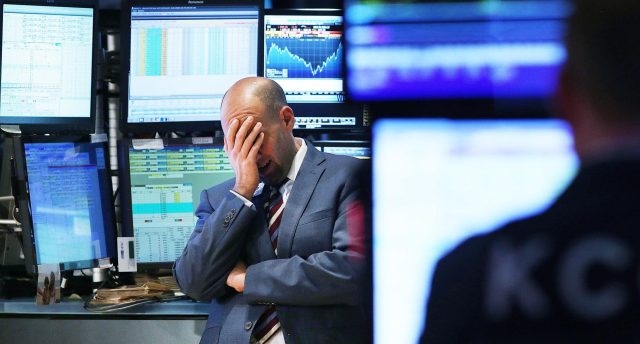It took years for western economies to recover from the 2008 recession. Credit: Spencer Platt/Getty

I know it’s August, and you’re probably on holiday or are grappling with inbox one zillion having just come back from holiday, but there’s a tiny little issue I’d like to bring to your attention. I’m not quite sure how to put this, but the global economy’s gone mad – stark-staring bonkers, in fact.
If you doubt me, take a look at the bond market. A bond is a tradable slice of government (or corporate) debt. In normal circumstances, a bond ‘matures’ after a fixed period of time, when the holder gets paid what the piece of paper originally sold for, plus the ‘coupon’ (i.e. the interest on the loan). This determines the bond’s yield. And this is where the madness comes in.
Bonds with negative yields – i.e. that pay back less than the original purchase price when they mature – not only exist, they are becoming wildly popular. Here’s Stephen Letts of ABC with the jaw-dropping numbers:
“The weirdness in financial markets at the moment seems boundless.
“In the past two weeks the proliferation of negative-yielding bonds has erupted — 30 per cent of the global, tradeable bond universe is being sold with a guaranteed loss attached to the coupon.
“That’s an eye-watering $US16.7 trillion dollars’ worth”
Governments are, in effect, charging lenders to lend them money.
This invites an obvious question: why would anyone agree to a deal like that? Wouldn’t they be better off just sitting on the money?
I’ll try to explain by analogy.
Have you ever had furniture stored in one of those out-of-town warehouses? If so, you’d expect to get your sofa and armchairs back in one piece, but you wouldn’t expect to get, say, an extra armchair by way of ‘interest’ on your ‘deposit’. In fact, you’d have to pay the storage company for the service of looking after your stuff.
That’s the logic behind a negative yield bond – it’s a payment to the issuer to look after your money. But, hang on, why can’t the money be lent out at interest – so that you earn a positive yield upon it?
Well, you could say the same about your surplus furniture. Instead of paying to have it stored, why not hire it out and make a profit?
The answer is that there’s no shortage of furniture; most people have too little living space, not too few things to fill it with. Moreover, the hassle and risk of hiring out your stuff is too much trouble – especially if you might want it back at short notice. It’s just much easier and safer to pay the professionals to store it for you.
Of course, there are many more uses for surplus money than surplus furniture – moving it around is easier too. However, the fact is that there’s more capital floating around the world right now than we can find (profitable) uses for. If this weren’t the case then interest rates wouldn’t be so low.
Like furniture, bad things can happen to financial wealth that isn’t looked after. It can be stolen, investments can fail, banks can go bust, asset prices can collapse, stock markets can crash. These risks need to be managed – and for institutions like pension funds with vast sums of money under their care, and powerful regulators to satisfy, the cost of that management adds up. By buying bonds for their investment portfolios, they are in effect getting governments (plus some corporations) to manage part of the risk for them. Indeed, demand can be so high and suitable alternatives so unavailable, that bonds sell at zero or negative yields:
An excellent briefing for Bloomberg by John Ainger shows where this is happening:
“Investors have to pay to own more than 80% of Germany’s federal and regional government bonds; almost the entire Danish government market is negative. The U.S. is one of a dwindling number of nations with no negative-yielding sovereign debt.”
In the short term, the recent rapid growth in demand for negative yield bonds is being driven by declining confidence in stock markets and property markets – with investors expecting stock and property values to fall in the near to medium term.
There are other signs that the money market expects a downturn in the economy. For instance, it’s normally the case that yields on bonds that mature in, say, ten years are higher than those that mature a lot earlier. That’s because long-term debt is seen as riskier – there’s simply more time for things to go badly wrong. However, at the moment, it’s the other way round – the short-term yields are higher than the long-term yields. This is called an inverted yield curve. (Don’t confuse ‘inverted’ with ‘negative’, in this context inverted just means that the market is pricing short-term debts as riskier than long-term debt.)
Yield curves have inverted at various points in the past. It’s a classic sign that the market is expecting a recession. However, there’s nothing classic about the current craze for negative yield bonds – the phenomenon barely existed more than a few years ago. What’s happened since is without precedent. As unpleasant as recessions are, we should be much more disturbed by the fact that $16 trillion dollars (and rising) are currently invested in products guaranteed to make a loss.
A healthy capitalist system is one that can both make a profit and reinvest it profitably. The corporates are still making money, but they no longer seem to know what to do with it. Things have got so bad they’re literally paying the state to take it off their hands.
They’ll be paying their taxes next.










Join the discussion
Join like minded readers that support our journalism by becoming a paid subscriber
To join the discussion in the comments, become a paid subscriber.
Join like minded readers that support our journalism, read unlimited articles and enjoy other subscriber-only benefits.
Subscribe